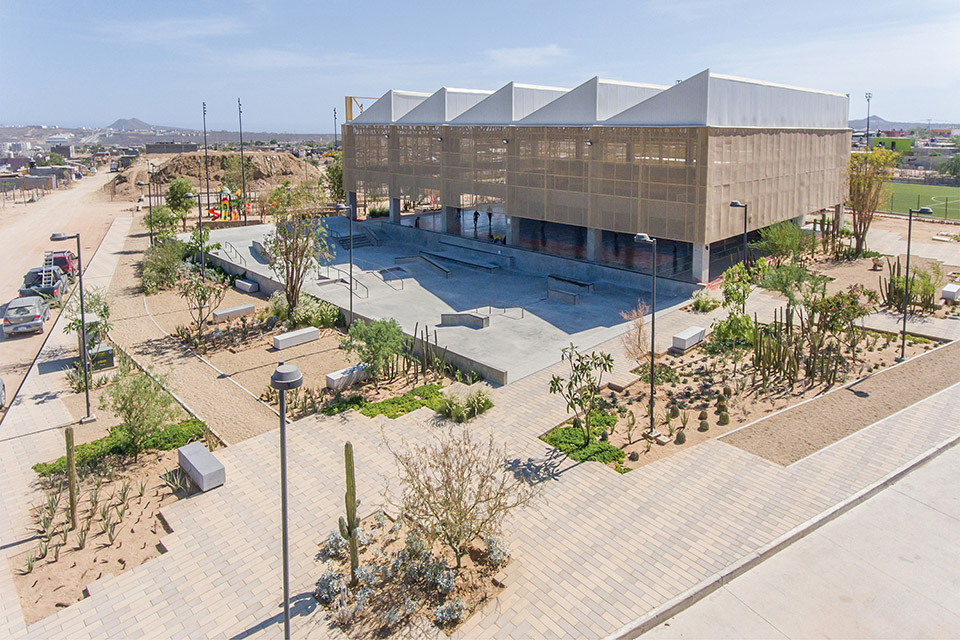
Photo Caption: Jardín de Sombras: Public Space as Infrastructure for Cities in the Desert is located in a marginal area north of Los Cabos, Baja California Sur. This project was designed by ORU-Oficina de Resiliencia Urbana, Julián Arroyo, Gabriel Azuara Pellicer, and Virens. Photo courtesy of Oficina de Resiliencia Urbana (ORU).
Adriana Chávez and Víctor Rico co-founded Oficina de Resiliencia Urbana (ORU) in Mexico City, Mexico. ORU was named among the 2023 Emerging Voices by the Architectural League of New York. Chávez teaches at Columbia University’s Graduate School of Architecture, Planning & Preservation and Syracuse University School of Architecture. Rico has taught at Universidad Anáhuac México and the National Autonomous University of Mexico (UNAM).
Chávez and Rico will present a lecture at 4:30 p.m. Monday, April 1, in Ken and Linda Sue Shollmier Hall, Room 250 of Vol Walker Hall, on the University of Arkansas campus, as part of the spring lecture series in the Fay Jones School of Architecture and Design.
In their lecture, “Collective Models of Design and Action,” Chávez and Rico will explore collective models of design and action within urban environments. The talk will begin with introducing ORU’s innovative practice, followed by an in-depth overview of their work, focusing on impactful projects in Mexico and Colombia. They will emphasize ORU’s community-centric and participatory approach, showcasing diverse initiatives from small-scale community projects to large-scale territorial planning.
Through Chávez and Rico’s presentation, attendees will gain valuable insights into ORU’s built urban design and public space projects and their extensive research endeavors. The lecture will culminate with a reflection on the evolving role of designers in addressing urban and environmental challenges, prompting the audience to consider the transformative potential of collective action in shaping resilient and sustainable cities.
ORU, which was co-founded by Chávez, Rico and Elena Tudela, is a design think tank that focuses on implementing innovative solutions for cities through urban design and landscape infrastructure with a water-sensitive approach. ORU’s team consolidates more than 10 years of experience in the academic, public and private sectors and various multilateral organizations.
The office explores the possibility of urban-environmental integration at different scales within multiple social, economic and political contexts. ORU works collaboratively, teaming up with the most experienced professionals in various knowledge fields to effectively connect design solutions to the most pressing needs in global urban regions and communities.
Chávez holds a Bachelor of Architecture from Universidad Iberoamericana, and a Master in Urbanism, Landscape and Ecology and a Master of Architecture II, both from Harvard Graduate School of Design. Rico holds a Bachelor of Architecture from Universidad Anáhuac México, a diploma in public space and safer cities from Universidad Iberoamericana, and a Master of Architecture in Urban Design from Harvard Graduate School of Design.
In addition to their lecture, Chávez and Rico will also lead the Together in Diversity and Design workshop from 1-4 p.m. Monday, April 1, working in collaboration with Gabriel Díaz Montemayor, assistant dean for Diversity, Equity and Inclusion and associate professor of landscape architecture. This workshop will present an approach to crafting narratives for collective engagement with communities, funders and government officials. Chávez and Rico will present different approaches based on ORU’s work to open a conversation for exploring how design can catalyze new futures.
During this workshop, students will craft a convincing narrative and create a pitch for their spring 2024 studio projects. Chávez and Rico will provide feedback and explore methods and tools for communicating design goals and opportunities. Students will reflect on their proposals and what could appeal to a specific audience. The workshop is open to all Fay Jones School students.
The school is pursuing continuing education credits for this lecture through the American Institute of Architects.
This lecture is free and open to the public. Seating is limited.



